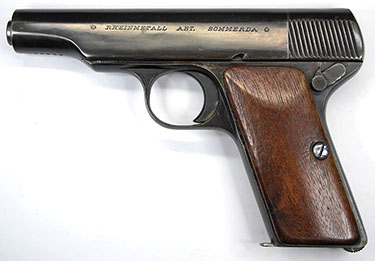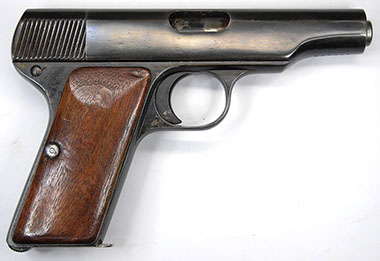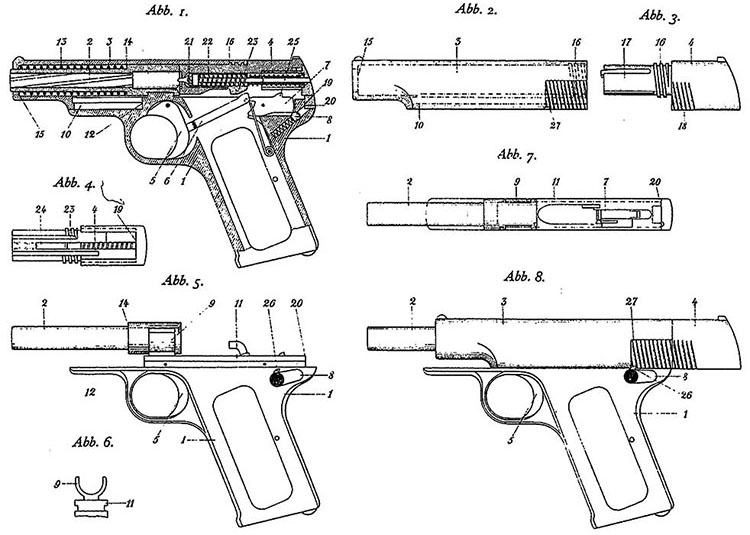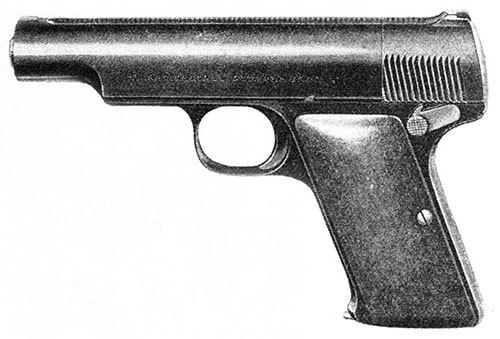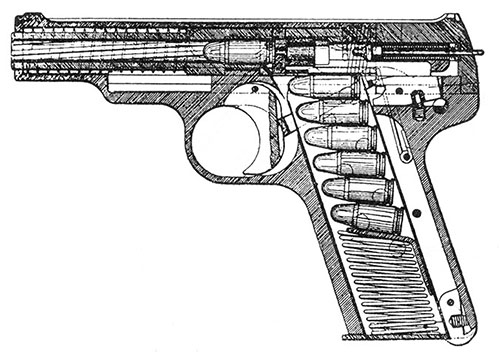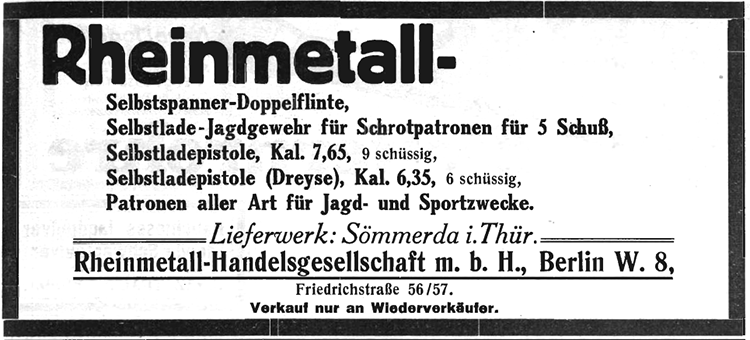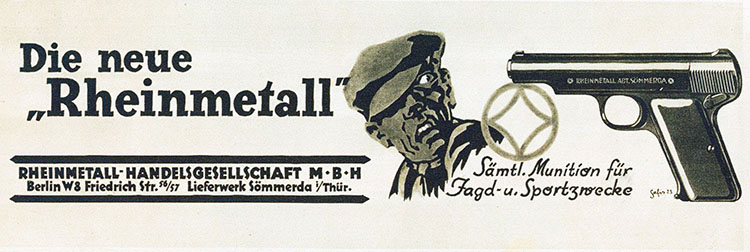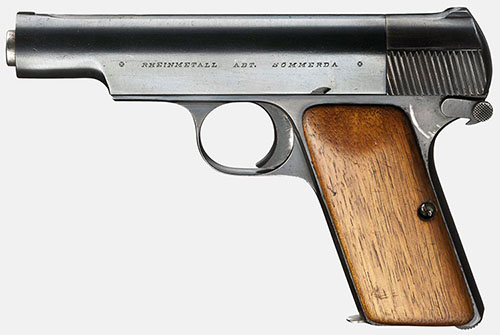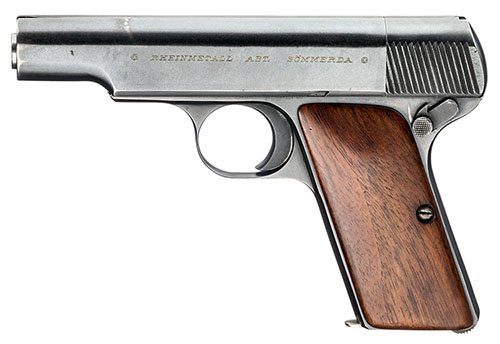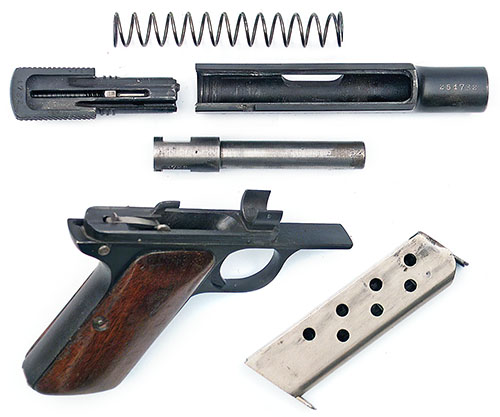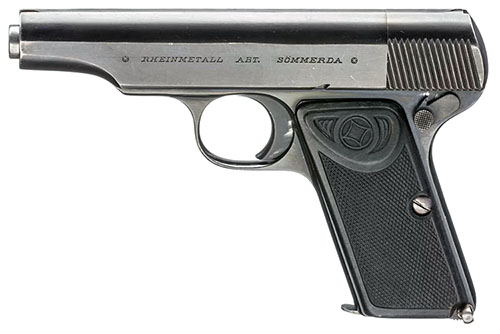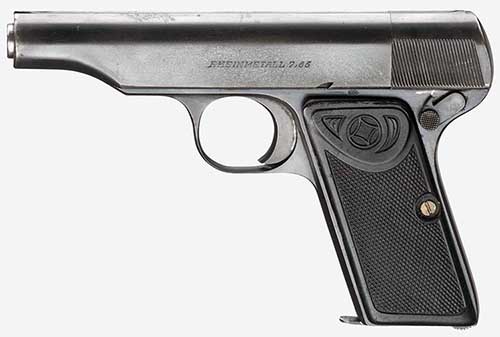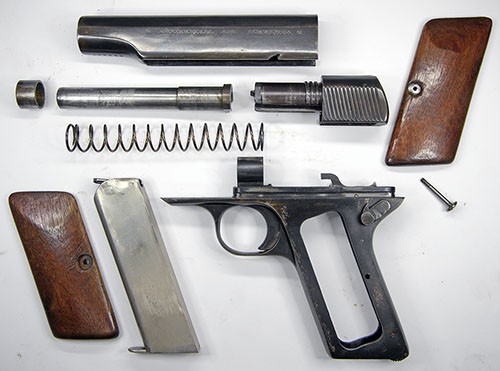 |
|||||||||||||||||||||||||||||||||||||||||||||||||||||||||||||||||||||||||||||||||||||||||||||||||||||||||||||||||||||||||||||||||||||||||||||||||||||||||||||||||||||||||||||||||||||||||||||||||||||||||||||||||||
|
The 7.65mm Rheinmetall Pistol by Ed Buffaloe I am not aware that anyone has ever called this gun a Model 1920 but the fact remains that this rather scarce semi-automatic pistol lacks a useful designation. It is most often referred to as “the Rhinemetall pistol”. Since it was patented in 1920, the model designation seems appropriate. German patent 405424 was filed 15 August 1920 but was not granted until 1 November 1924.
The patent shows a striker-fired unlocked breech pistol with raised integral sights, a cradle-like U-shaped barrel mount, and a separate breech block that screws into the rear of the slide. The reinforced area at the breech end of the barrel has a cutout on its bottom, allowing the barrel to be press fit into its cradle on the frame. The gun is described as having a hook on the safety lever that allows the slide to be locked open for disassembly. The trigger is pulled to lower the sear and the breech block is unscrewed from the slide, making disassembly quick and easy. The breech block contains the striker, which also features a cocking indicator which protrudes through the rear when cocked, and the extractor. The gun breaks down into five parts: the slide, breech block, barrel, frame, and magazine. The design is simple and robust.
The disconnector is a lobe on the right-side upper end of the stirrup-shaped transfer bar; when the slide moves out of battery, it depresses the transfer bar so it cannot engage the sear. The manual safety lever on the grip tang rotates to the rear to block the sear and is easily felt by the thumb of a right-handed shooter. With the safety engaged, the gun cannot be cocked. There is no magazine safety. The majority of grip plates are of wood, though late guns may be found with checkered hard rubber grip plates. The early magazine is nickel plated, holds 8 cartridges, and has seven staggered viewing holes on the right side only. The magazine has a simple flat follower and is stamped on the baseplate with the diamond-in-a-circle trademark of Rheinmetall. Blued magazines are also known in later production pistols. Many commentators note the external resemblance to the Model 1910 FN Browning, despite clear differences. Besides the unique disassembly method, the Rheinmetall pistol has a more acute grip angle and lacks a grip safety, but does retain Browning’s superior transfer-bar design that runs on both sides of the magazine well and provides a smooth let-off for the trigger.
Matthews, in his book Firearms Identification, notes: ‘Apparently the development of this model was still under way in 1921, as Bock states in the 1923 edition of his “Moderne Fastfeuerwaffen” that he had been permitted to fire a hand-made specimen in 1921.’ In fact, after the treaty of Versailles, weapons production in Germany was banned by the Interallied Commission of Control until sometime in 1921, which information is consistent with Bock’s statement that he fired one of the new guns sometime in 1921. However, since the patent was filed in August 1920, it is clear that Rheinmetall was already secretly working on the new weapon before the ban was lifted. Hogg & Weeks, in Pistols of the World, state that the gun was first marketed in 1922. I lack firm evidence for this date, but it is consistent with what little additional information I have been able to gather. Production may have begun sometime in 1921, while marketing followed in 1922, but there seems no way to know for certain. Hans-Joachim Tillig, in his article Die Selbstladepistolen Dreyse und Rheinmetall, does not attempt to provide a date for the start of production, merely noting that it was patented on 15 August 1920. However, he does state that “[production] lasted until inflation peaked in 1923”. Tillig also notes “...there seems to have been a seamless transition to the new design Rheinmetall pistol...”, meaning that the serial numbers of the Model 1920 take up where the Dreyse Model 1907 serial numbers left off. There may have been some minor overlap, but I have not seen direct evidence.
My collection of 1907 Dreyse photographs goes up to serial number 250283a. Many of the very late Dreyse pistols have parts from various phases of production, so it is clear that Rheinmetall was trying to use up every part in its stock; possibly old Model 1907 parts were found, assembled into pistols, and numbered after Model 1920 production commenced. Tillig suggested that about 12,000 of the Model 1920 Rheinmetall pistol were made. The lowest serial number I have recorded is 251007 and the highest is 266168. Based on this evidence, I suggest that the Model 1920 serial numbers may have begun at 251000. So, at this writing, I calculate that slightly more than 15,000 may have been made made. Considering that the production capacity of the Sömmerda division of Rheinmetall at the end of the war was quite high, despite war losses and heavy layoffs afterward, it is easily conceivable that Rheinmetall could have manufactured 15,000 pistols in two to four years. Rheinmetall’s large factory in Düsseldorf was closed in 1921 and partially destroyed by French and Belgian troops during the occupation of the Ruhr, which started in late 1923, but this did not affect Sömmerda which may well have continued producing pistols until the company was sold.
A number of sources indicate that Model 1920 production may have lasted until 1926 or 1927, but direct evidence is lacking. I have an advertisement for the Model 1920 from the German gunsmith journal Waffenschmied which dates to 16 April 1923; the Model 1920 is identifiable only by the statement that it holds 9 shots. If Tillig is correct that production ended in 1923, then production ended before the patent was granted. Considering the hyperinflation of the Weimar era, Rheinmetall needed to sell whatever they produced as quickly as possible.
Another rare advertisement was posted on a German gun forum, said to be from a 1924 magazine, showing a gun with raised sights somewhat similar to the one illustrated in Bock’s 1923 book. It seems likely that Rheinmetall was still marketing the new gun in 1924, but the company was bought by the German government in 1925, after which production was refocused on heavy weapons and industrial machinery.
There are four variants though I have been unable to examine all of them in person. Nevertheless, I can extrapolate from photographs, forum posts, and Tillig’s 1989 article.
The first variant is more or less what is shown in the patent, featuring raised sights with a grooved flat area between, and a U-shaped barrel mount on the frame. However, I have not documented a production pistol with the protrusion at the front base of the grip which is shown in the patent drawing and in the handmade prototype. Tillig states that slide serrations “...were initially raised, so they protruded a little on the sides”. Slide serrations also extend from front to rear of the breech block; I count 17 triangular-cut serrations. The finish is a deep rust blue and the grip plates are of plain wood. The inscription is on the left side of the slide in italic serif capitals: RHEINMETALL ABT. SÖMMERDA On either end of the inscription is the diamond-in-a-circle trademark of Rheinmetall (registered in 1894). The serial number is on the bottom of the slide, just behind the muzzle. Partial serial numbers are to be found stamped on the bottom of the breech block and on the barrel. I have not found a serial number on the frame. A few scarce pistols are stamped for export, usually on the bow of the trigger guard: GERMANY.
Tillig states that after about 1000 pistols were made the raised sights were eliminated in favor of a groove down the top of the slide and breech block. A V-notch is formed at the rear, and the front features a tiny raised sight in the groove; these are almost identical to the sights on a Model 1910 FN Browning. The raised serrations on the side of the breech block were also eliminated. Serrations are reduced to 15, leaving a small flat area at the rear. These changes were all made to reduce cost and speed production.
The third variant is externally identical to the second variant. Only the mounting method for the barrel is changed. The mount is now circular and the barrel fits into it bayonette-style. Just behind the circular mount is a small lug on the frame onto which the barrel is slotted and then rotated approximately 30° to lock it in place. This change occurred somewhere between serial numbers 254091 and 254849. Please write to me if you have a gun in this range.* Toward the end of third variant production we begin to see grip plates made of hard rubber or possibly bakelite. The grips are checkered and have a thumb-rest area with the Rhinemetall diamond-in-a-circle trademark. I have documented a number of third variant pistols with the slide inscription slightly skewed, including the one at the top of this page.
Fourth variant guns have 30 very fine triangular-cut serrations on the breech block. Toward the end of production we begin to observe a new inscription on the left side of the slide: RHEINMETALL 7,65 There are some late guns with the earlier serrations and the late slide inscription, and also with wooden grips.
* Write to edbuffaloe@unblinkingeye.com. |
|||||||||||||||||||||||||||||||||||||||||||||||||||||||||||||||||||||||||||||||||||||||||||||||||||||||||||||||||||||||||||||||||||||||||||||||||||||||||||||||||||||||||||||||||||||||||||||||||||||||||||||||||||
|
|||||||||||||||||||||||||||||||||||||||||||||||||||||||||||||||||||||||||||||||||||||||||||||||||||||||||||||||||||||||||||||||||||||||||||||||||||||||||||||||||||||||||||||||||||||||||||||||||||||||||||||||||||
|
Copyright 2023 by Ed Buffaloe. All rights reserved. |
|||||||||||||||||||||||||||||||||||||||||||||||||||||||||||||||||||||||||||||||||||||||||||||||||||||||||||||||||||||||||||||||||||||||||||||||||||||||||||||||||||||||||||||||||||||||||||||||||||||||||||||||||||
|
|
|||||||||||||||||||||||||||||||||||||||||||||||||||||||||||||||||||||||||||||||||||||||||||||||||||||||||||||||||||||||||||||||||||||||||||||||||||||||||||||||||||||||||||||||||||||||||||||||||||||||||||||||||||
